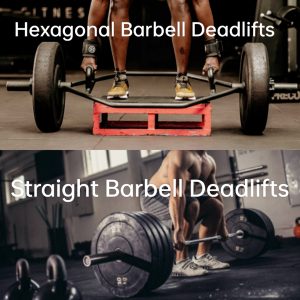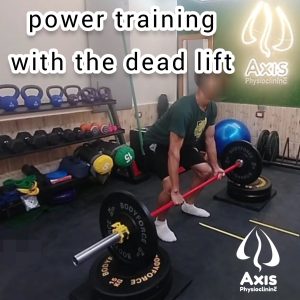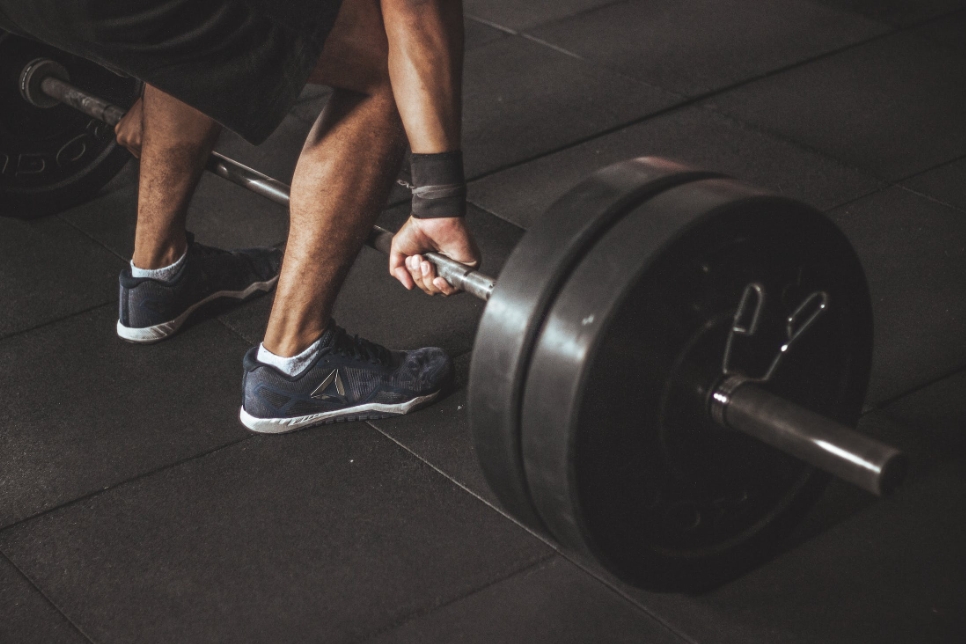Introduction
The deadlift is a multi-joint resistance exercise that can be done in a number of training environments. The lifter must grab a barbell at mid-shank level in a squat stance and extend the lower back, hip, knee, and ankle joints to elevate the weight. Any activity that requires strong knee, hip, and trunk extensors could benefit from including the deadlift in the training regimen. A simple movement pattern should not be judged solely on appearance because the complexity of mastering proper lifting technique and implementing the proper training programme demonstrate exactly how difficult it can be to maximise performance, and the deadlift is one of those exercises. So, in this piece of writing, I will go over the essential aspects concerning types and biomechanical considerations in order to reduce injury and improve performance.
Biomechanical considerations
The deadlift is most commonly employed to increase maximum strength, with the assumption that big loads lifted will generate enormous muscle forces and encourage adaptation. A variety of studies have been conducted to quantify biomechanical characteristics during the deadlift. Large muscle moments can be produced, with the largest values observed at the hip, lumbar spine, ankle, and knee (BROWN, E.W., and K. ABANI, 1985; CHOLEWICKI, J., et al., 1991). In conjunction with enormous muscle moments, research has revealed significant internal forces when heavy loads are used in the deadlift (BROWN, E.W., and K. ABANI, 1985; CHOLEWICKI, J., et al., 1991; GRANHED, H., et al., 1987). Brown and Abani (1985) measured net joint forces at the hip, knee, and ankle joints of adolescent powerlifters ranging from 1450 N to 1550 N during competition. The authors discovered that contestants who lifted the biggest loads felt the most internal forces (BROWN, E.W., and K. ABANI, 1985). Studies using linked segment models to estimate forces at the lumbar spine have found extraordinarily high disc compression forces during the deadlift. During a national-level competition, Cholewicki et al. (1991) measured L4/L5 disc compression forces ranging from 14350 N to 17192 N for male and female powerlifters. Lumbar disc compression forces as high as 36400 N have been observed for world-class athletes lifting extraordinarily heavy loads (GRANHED, H., et al. 1987). Injury is possible as a result of the very substantial internal pressures and moments exerted during the deadlift (CHOLEWICKI, J., et al., 1991; GRANHED, H., et al., 1987). Maintaining lumbar lordosis during maximum deadlifts is also exceedingly difficult, if not impossible. Furthermore, maximum deadlifts generate an increased kyphotic curve of the thoracic spinal area.
In conclusion, optimal lifting style varies widely across individuals. Using the leg-lift method when completing exceptionally heavy traditional-style deadlifts does not appear to be the preferable strategy or even practicable (Gracovetsky S. and Farfan H. 1986). Furthermore, the capacity to maintain lumbar lordosis decreases as lifting loads grow, owing in part to the erectors’ failure to overcome the large forces generated by the hip extensor muscles during the first phase of the lift (Gracovetsky S. and Farfan H. 1986). When performing maximum-effort conventional-style deadlifts, the lifter usually uses a back-lift or a modified back-lift technique with a somewhat exaggerated kyphotic thoracic curve (Gracovetsky S. and Farfan H. 1986; Hales ME et al. 2009). But, let’s go into more detail:
Straight barbell deadlifts versus hexagonal barbell deadlifts

The barbell used to conduct the deadlift had a substantial impact on a number of kinematic and kinetic factors. The deadlift with a hexagonal barbell has been shown to alleviate lumbar stress (Gentry, M., et al., 1987; Shepherd, G., 2009). The hypothesis holds that the hexagonal barbell allows the lifter to adopt a more upright lifting posture, lowering the resistance moment arm at the lumbar spine. Swinton P. A. et al. (2011) concluded that by doing the deadlift with varied barbells, the biomechanical stimulus may be changed. The straight bar deadlift is advised if the training goal is to target the lumbar area and recruit the erector spinae muscles as much as possible. The hexagonal barbell deadlift is an effective alternative to the squat and a recommended exercise to utilise in the last phases of low back therapy.
Sumo deadlifts vs. traditional deadlifts

There are two types of deadlifts: standard and sumo. Some research has compared the biomechanical parameters of sumo and standard deadlifts. McGuigan and Wilson (1996) conducted a kinematic analysis during a regional powerlifting competition and found that the sumo deadlift had a more upright trunk, less hip flexion at barbell liftoff, and a wider shank range of motion than the conventional deadlift. Cholewicki et al. (1991) measured lumbar loads as well as hip and knee moments during a national powerlifting competition and discovered that the conventional group had significantly greater L4-L5 shear forces and moments, whereas hip and knee moments were not significantly different between the two deadlift styles. Escamilla et al. (2000; 2001) performed three-dimensional (3-D) kinematic and kinetic assessments during a national masters powerlifting championship (Escamilla et al. 2000) and the Special Olympics World Games (Escamilla et al. 2001). There were some substantial changes in joint and segment angles, mechanical work, ankle, knee, and hip moments, and moment arms between sumo and conventional deadlifts. Traditional deadlifts produced ankle plantar flexor moments, whereas sumo deadlifts produced ankle dorsiflexor moments. The sumo deadlift exhibited significantly greater knee extensor moments than the standard deadlift, but there were no significant differences in hip extensor moments.
Consider the muscle groups that have the most potential for attaining maximum strength. The traditional style deadlift produces significant hip extensor moments, but the sumo style deadlift produces both knee and hip extensor moments, as well as hip adductor moments (GRANHED, H., R. et al. 1987). The sumo-type deadlift is appropriate for a lifter with powerful knee and hip extensors and above-average hip flexibility. If the lifter has powerful hip and trunk extensors but less than normal hip flexibility, the therapist or coach may suggest adopting the traditional technique. Escamilla et al. (2002) examined muscle activity during sumo and conventional deadlifts, as well as belt and no-belt circumstances. The authors concluded that the sumo deadlift is more effective than the conventional deadlift in recruiting the vastus medialis, vastus lateralis, and tibialis anterior, but the conventional deadlift is more effective in recruiting the medial gastrocnemius. The predominant effect of wearing a belt was increased rectus abdominis activity and decreased external oblique activity. As a result, wearing a belt during submaximal training appears to have little effect on muscular activation patterns, except in the abdominal musculature. Strength athletes can use either the sumo or conventional deadlift depending on the muscles they need to develop according to their training or recuperation programmes. The deadlift may be an efficient closed kinetic chain exercise since it generates moderate to high co-contractions from the quadriceps, hamstrings, and gastrocnemius.
A word regarding dead lifts
(McGill S.M., 2009):

Torso power is commonly related to power lifting and the dead lift. Given the slowness of the activity, the dead lift is not a power movement. Too many power lifters train slowly, trying near-maximal lifts but making little progress. Instead, many people notice superior performance gains when they use actual power training methods. One example of deadlift power training would be to drop the weight and lift at a much faster pace. This strategy attracts a new population of motor units. Many athletes struggle with the draw from the floor, particularly those who train with dead lifts but are not competitive power lifters. Safety can be improved for these athletes by raising the bar and weights onto blocks for the initial pull. The athlete focuses on the initial set position, visualising the move, and recruiting muscles. The lumbar spine is locked in a neutral position, and extensor stress is felt in the hips. Then, on cue (or at the athlete’s initiative), a bursting hip extension occurs, resulting in perfect vertical projection of force on the bar. Many athletes use the hip hinge as a power-imaging activity.
The effectiveness of deadlifts in a mechanical low back pain rehabilitation course
The deadlift was found to have the highest muscle activation of paraspinal musculature in those without LBP compared to other exercises (Colado JC, et al. 2011), which may be relevant for those with LBP who have increased slumped posture with sitting and decreased lumbar multifidus activation (Gordon R, Bloxham S. 2016). There has been little research that looks into the effectiveness of including deadlifts as part of a rehabilitation programme for mechanical low back pain. A study conducted by Fischer et al. (2021) discovered that exercise programmes incorporating deadlifts can result in improvements in both pain and function for people suffering from LBP, but they were not proven to be more helpful than low-load motor control exercise. Furthermore, those with LBP who have lower reported pain levels and stronger baseline lumbar extension strength may be the best candidates for a deadlift-based training programme. However, further study is needed to compare exercise programmes involving deadlifts to other therapies for people suffering from low back pain.
The key question now is, “Which patients with low back pain benefit from deadlift?”
Recent research suggests that the deadlift exercise may be useful in reducing pain intensity and boosting activity for the majority, but not all, of patients with a dominant pattern of mechanical low back pain. A case study (Holmberg, D., et al., 2012) and a randomised controlled trial (Aasa, B., et al., 2015) suggested that deadlift training with an individualised progression in intensity and volume could be effective in reducing pain and disability in patients with a dominant pattern of mechanical low back pain. After an 8-week training period, two-thirds of the patients experienced a clinically relevant improvement (greater than 30% change (Ostelo RW, et al. 2008)) in pain intensity and activity, according to the randomised controlled trial (Aasa B, et al. 2015). Patients improved their trunk muscle strength and endurance as well (Aasa B, et al. 2015). Nonetheless, the discovery that one-third of patients did not obtain a clinically relevant reduction in pain intensity or activity raises the question of whether and how these patients differ from those who benefited from deadlift training. Berglund L. et al. (2015) conducted a study to determine which baseline individual characteristics could predict activity, disability, and pain severity in patients with mechanical low back pain after an 8-week training period incorporating the deadlift as a rehabilitative exercise. Strength and conditioning professionals or sports physiotherapists who use the deadlift as a rehabilitative exercise for individuals with mechanical low back pain must ensure that clients have sufficient back extensor strength and endurance, as well as a low enough pain intensity level, to benefit from deadlift training.
To summarise, in order to maximise deadlift performance, the strength coach and sports physiotherapist should investigate various barbell and lift types and identify a style and barbell that is most appropriate for the athlete. The strength and conditioning specialist or sports physiotherapist could benefit from having an awareness of the relationships between muscle architecture, anthropometrics, and fibre composition to aid in the selection process.

References
- Aasa, B, Berglund, L, Michaelson, P, and Aasa, U. Individualized low load motor control exercises and education vs a high load lifting exercise and education to increase function in patients with low back pain—a randomized controlled trial. J Orthop Sports Phys Ther 45: 77–85, 2015.
- Berglund, L, Aasa, B, Hellqvist, J, Michaelson, P, and Aasa, U. Which patients with low back pain benefit from deadlift training?. J Strength Cond Res 29(7): 1803–1811, 2015.
- BEVAN, H.R., P.J. BUNCE, N.J. OWEN, M.A. BENNETT, C.J. COOK, D.J. CUNNINGHAM, R.U. NEWTON, and L.P. KILDUFF. Optimal loading for the development of peak power output in professional rugby players. J. Strength Cond. Res. 24(1):43-47. 2010.
- BROWN, E.W., and K. ABANI. Kinematic and kinetics of the dead lift in adolescent power lifters. Med. Sci. Sports Exerc. 17(5):554 – 566. 1985.
- CHOLEWICKI, J., S.M. MCGILL, and R.W. NORMAN. Lumbar spine loads during the lifting of extremely heavy weights. Med. Sci. Sports Exerc. 23(10):1179 – 1186. 1991.
- Colado JC, Pablos C, Chulvi-Medrano I, et al. The progression of paraspinal muscle recruitment intensity in localized and global strength training exercises is not based on instability alone. Arch Phys Med Rehabil. 2011;92(11):1875–1883.
- Escamilla RF, Francisco AC, Fleisig GS, Barrentine SW, Welch CM, Kayes AV, Speer KP, Andrews JR. A three-dimensional biomechanical analysis of sumo and conventional style deadlifts. Med Sci Sports Exerc. 2000 Jul;32(7):1265-75.
- Escamilla RF, Lowry TM, Osbahr DC, Speer KP. Biomechanical analysis of the deadlift during the 1999 Special Olympics World Games. Med Sci Sports Exerc. 2001 Aug;33(8):1345-53.
- Escamilla RF, Francisco AC, Kayes AV, Speer KP, Moorman CT 3rd. An electromyographic analysis of sumo and conventional style deadlifts. Med Sci Sports Exerc. 2002 Apr;34(4):682-8.
- GENTRY, M., D. PRATT, and T. CATERISANO. Introducing the Trap Bar. Nat. Strength Cond. Assoc. J. 9(3):54 – 55. 1987.
- Gracovetsky S and Farfan H. The optimum spine. Spine (Phila Pa 1976) 11: 543–572, 1986.
- GRANHED, H., R. JONSON, and T. HANSSON. The loads on the lumbar spine during extreme weight lifting. Spine. 12(2):146 – 149. 1987.
- Gordon R, Bloxham S. A systematic review of the effects of exercise and physical activity on non-specific chronic low back pain. Healthcare. 2016;4(2):22.
- Hales ME, Johnson BF, and Johnson JT. Kinematic analysis of the powerlifting style squat and the conventional deadlift during competition: is there a cross-over effect between lifts? J Strength Cond Res 23:2574–2580, 2009.
- Holmberg, D, Crantz, H, and Michaelson, P. Treating persistent low back pain with deadlift training: a single subject experimental design with a 15-month follow-up. Adv Physiother 14: 61–70, 2012.
- McGill, S.M. (2009) Ultimate back fitness and performance – Fourth Edition, Backfitpro Inc., Waterloo, Canada, (www.backfitpro.com).
- MCGUIGAN, M. R. M., and B. D. WILSON. Biomechanical analysis of the deadlift. J. Strength Condit. Res. 10:250–255, 1996.
- Ostelo, RW, Deyo, RA, Stratford, P, Waddell, G, Croft, P, Von Korff, M, Bouter, LM, and de Vet, HC. Interpreting change scores for pain and functional status in low back pain: Towards international consensus regarding minimal important change. Spine 33: 90–94, 2008.
- SHEPARD, G. Bigger, Faster, Stronger. 2nd ed. Champaign, IL: Human Kinetics, 2009. pp. 93 – 101.
- Swinton PA, Stewart A, Agouris I, Keogh JW, Lloyd R. A biomechanical analysis of straight and hexagonal barbell deadlifts using submaximal loads. J Strength Cond Res. 2011 Jul;25(7):2000-9.
